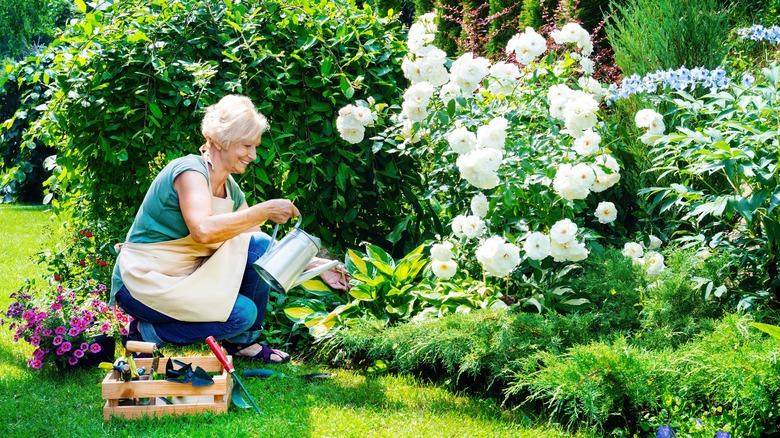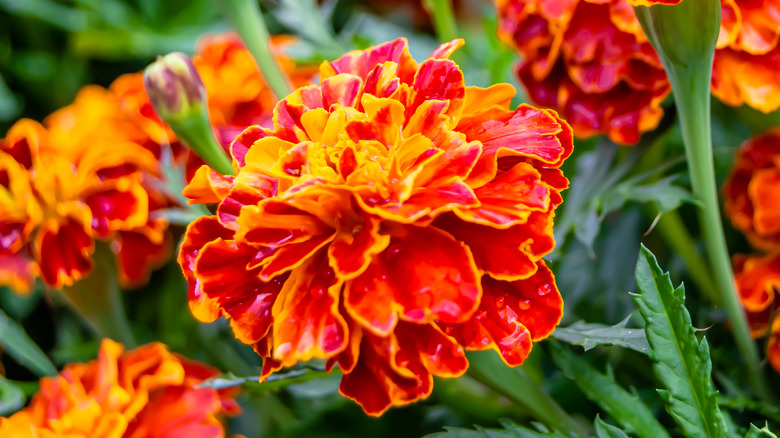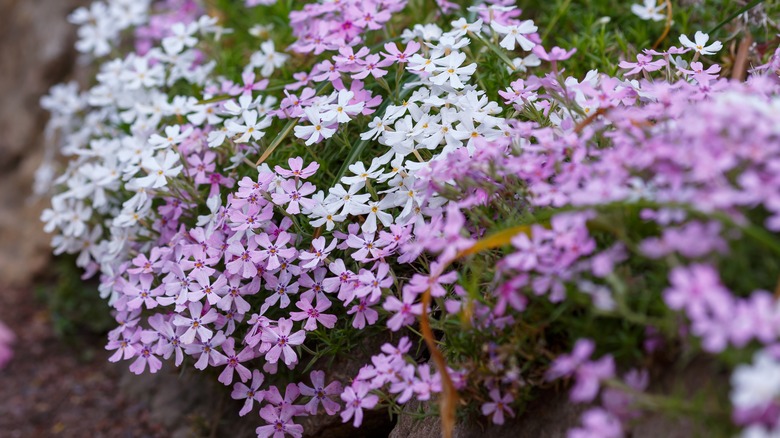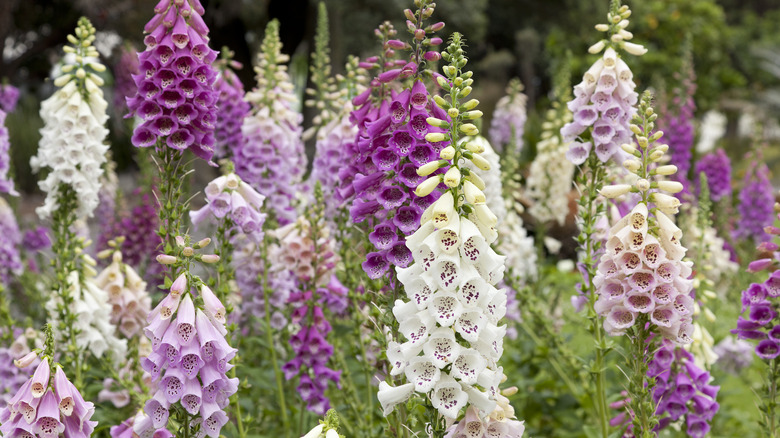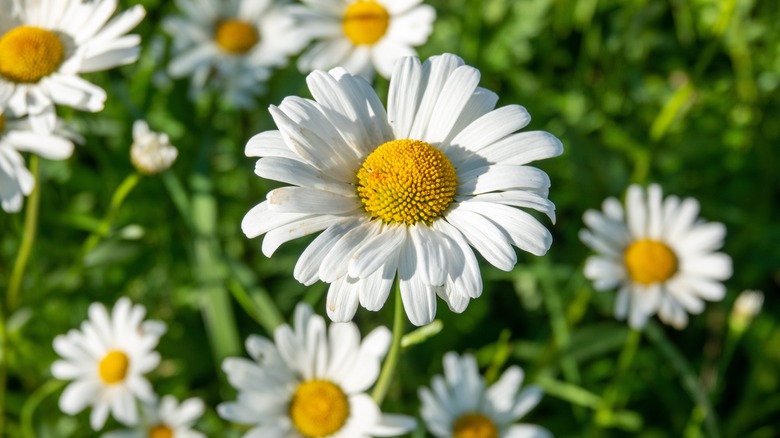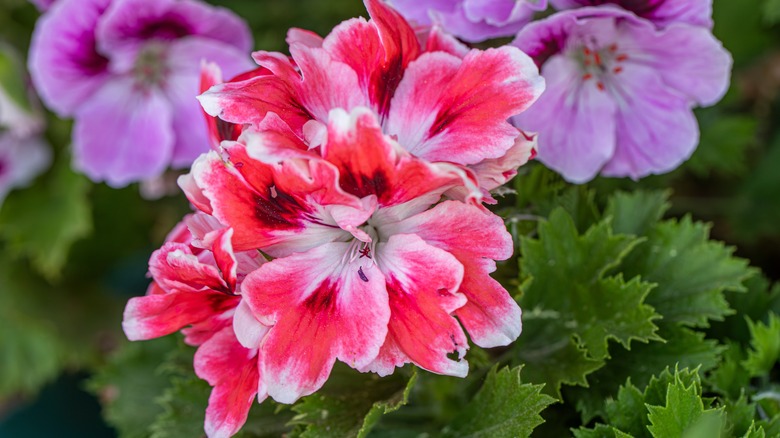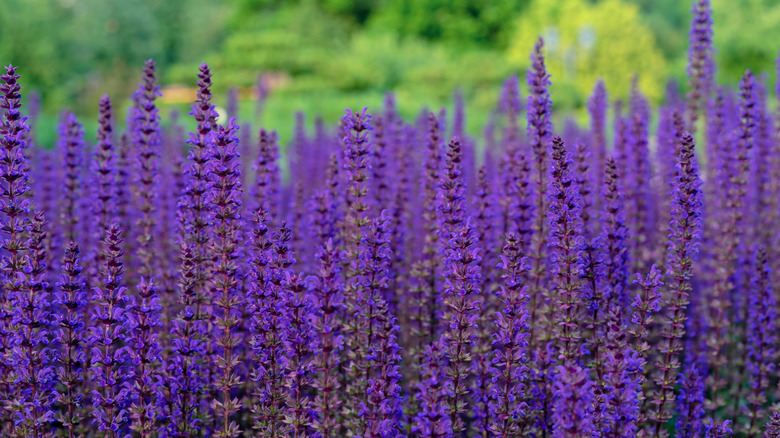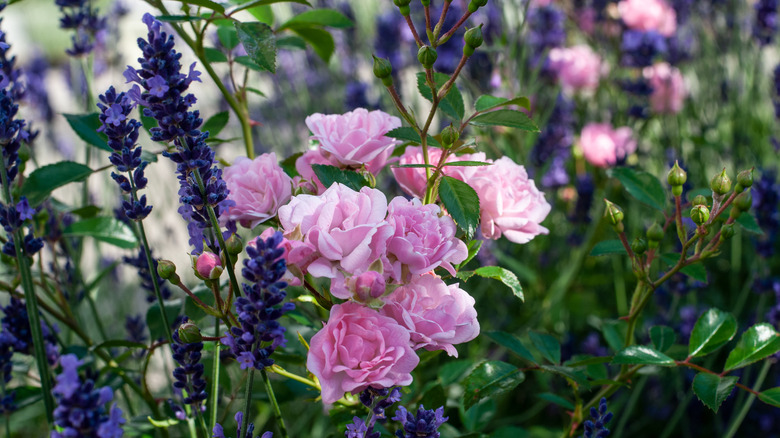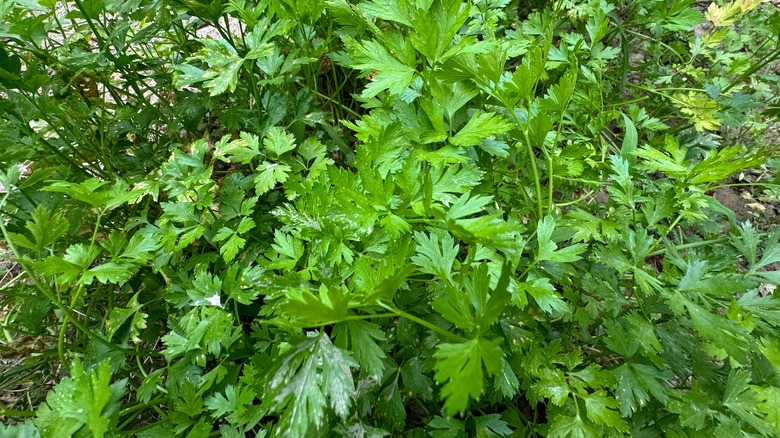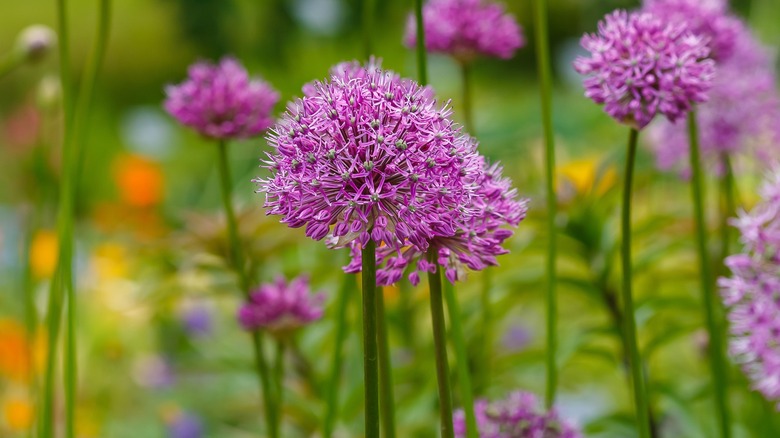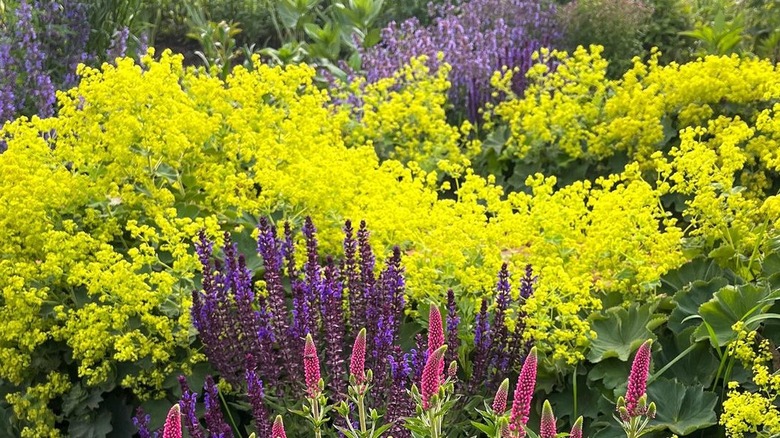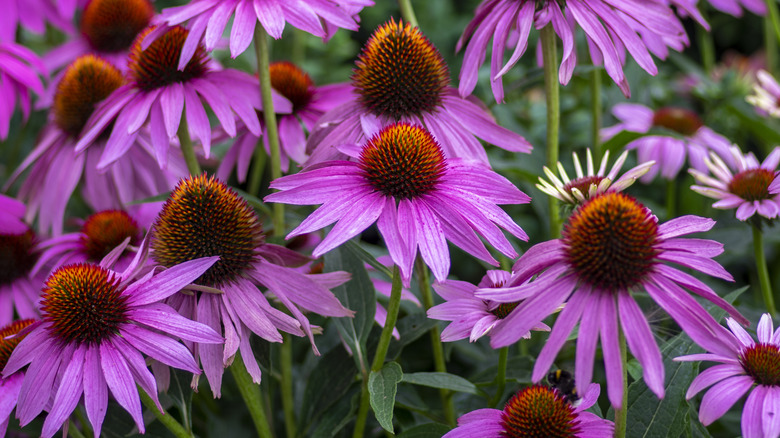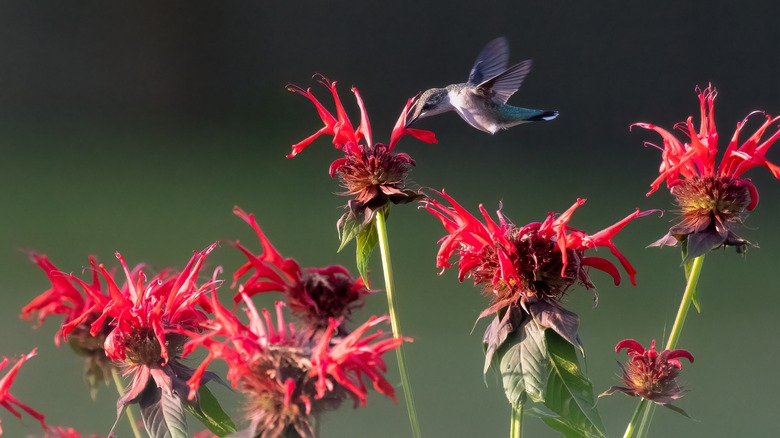The Best Companion Plants That Will Ensure Your Roses Are Happy And Healthy
Roses make a wonderful addition to any garden. Quite possibly the most popular flower ever, people have been cultivating roses for over 5,000 years. Despite this longevity, roses can be susceptible to several different types of pests and diseases, such as aphids, Japanese beetles, powdery mildew, and black spot. This is why the budding rose gardener would do well to add companion plants.
There are several factors that one should consider when it comes to choosing companion plants. You want to cultivate plants that give your garden visual depth, colored variety, and enhanced beauty. More importantly, however, are the companions that are going to aid in the overall health of your roses.
Think of companion plants as the Samwise Gamgee and Frodo Baggins pairings of the flower world. Companion plants should aid, but not outshine, the main attraction. So, if you choose any one of these 12 companion plants, your rose garden will continue to be happy and healthy for a long time to come.
Marigolds bring vibrancy and deter pests
If gardeners were only allowed a single choice for a companion plant to their beloved roses, it is very likely that they would choose marigolds. These wonderful plants are virtually indestructible, being able to thrive in USDA Hardiness Zones 2 through 11. Depending on the zone, they can be planted either as annuals or perennials. Once they are in the ground, all they need to thrive are sun and water. This hardiness, along with several other benefits, makes them ideal for planting alongside roses.
Marigolds come in a primary coloration of orange and gold, allowing them to stand out among the rose beds. Marigolds particularly compliment similarly colored yellow and orange rose varieties, but also offer a striking contrast to white and pink roses. Marigolds grow fairly low, reaching an average of 4 feet. This height allows them to add a great visual appeal to the base of your rose garden, especially if you have taller varieties like climbing roses.
Besides looking fantastic, marigolds also offer a load of benefits for roses. They serve as an enormous attractor for pollinators like bees and butterflies. Marigolds also contain strong compounds that emit a scent that repels harmful pests such as root-knot nematodes and hornworms. If you've experienced problems with these kinds of pests, plant marigolds alongside your roses next season.
Prevent powdery mildew with the right phlox
Phlox is an interesting rose companion for a number of reasons. For starters, it looks absolutely incredible, but in a way that only serves to enhance rather than take away from the beauty of the roses. Where marigolds are lower to the ground and vibrantly sunny, phlox can get quite tall and come in a variety of different colors. Some of the most stunning varieties, such as Forever Pink, White David, and Purple Goliath have extraordinary, five pedaled blooms that emit strong, sweet fragrance, and offer excellent visual contrast to roses.
One word of caution when it comes to phlox is that certain types can be susceptible to powdery mildew. This is a fungal disease that eats away at the stems and leaves of plants, often leaving powder shaded pockmarks all over the place. Powdery mildew usually occurs when there is not enough airflow through the garden, which causes moisture to build up and become fungus.
As phlox has a tendency to grow heavy, you'll need to make sure you are sowing it back from your roses and pruning it in order to maintain airflow. Make sure you plant it in a space that has full sun, as that will expel moisture. Also, the phlox varieties listed earlier are known to be resistant to the powdery mildew. So, stick with those if you can find them.
Foxglove is hardy and attracts pollinators
Look up any list of "perennials to plant in your garden" and foxgloves are going to be on them. Tall and teeming with bulbous, bell-shaped flowers, foxgloves make for a stunning visual contrast to rose bushes. Where roses find their beauty in their fragrance and their layered petals, foxgloves opt for a simpler route, favoring uniquely shaped, individual blooms that climb from a central stem. They come in two main color variations. Common foxglove is white, while purple foxglove is, well, purple.
Though they don't have health benefits the way marigolds do, foxgloves main contribution, besides looking pretty, is to attract pollinators to the garden. Bees, and especially butterflies, adore foxglove, readily busying themselves sourcing pollen from the wonderful bell blooms along the spire.
Another thing that makes foxglove particularly attractive as a companion plant to roses is the fact that, though they require full sun to thrive, they can grow almost anywhere. They particularly love rocky and degraded soil, so if you have any of that around where you're planning on putting roses, plant foxglove!
Shasta daisies are simple and drought-resistant
When it comes to simple beauty, it is hard to think of a better example than the Shasta daisy. A central yellow eye serves as the focal point to the thin, white petals that fan out like the sun. They grow in large bushels that are about 2 feet in height, so utilizing them as a border will allow the daisies to catch visitors' eyes and draw them upwards towards the main event: your roses.
The great thing about Shasta daisies as a companion to roses is that they require next to no care. While roses need to be tended to and cared for year after year with pruning, compost, and the like, Shasta daisies need only be planted once and will continue to reseed and grow again for years. They are extremely hardy, being able to thrive in near drought conditions when other plants will be withering.
It is too true that once a rose blooms, it does not stick around for very long. Not so with Shasta daisies. They will continue to bloom throughout the summer and straight into the fall, allowing your rose garden to continue to have color and vibrancy long after the stars have gone backstage for the season.
The strong scent of geranium deters several pests
Geraniums make for an interesting visual companion to rose plants. Another flower that grows relatively low and would do well as a border plant, geraniums are notable for their wide, almost drooping petals that fan outwards from a deep central well. Their numerous colors, such as red, peach, and burgundy, come mottled with white, and they grow in clusters of several flowers. However, while they are beautiful, it is not for their looks alone that you should plant geraniums alongside your roses.
Like the marigolds, geraniums aid roses in numerous different ways. When planted at the base of a rose bush, geraniums will help ward off diseases and numerous different pests. Specifically, they are excellent at warding off aphids and Japanese beetles, both of which are rose eaters.
It is the geranium's strong, sweet scent that drives these pests away. They share common chemistry with roses, and can often be mistaken for roses themselves. Therefore, they only serve to amplify the overall scent of your garden. Geranium is also known to ward off the likes of mosquitoes, so having them in the garden for that alone should make them worthy of planting.
Russian sage brings a visual pop to your garden
With their tall, purple blossomed stalks that flow in the wind like tall grass, Russian sage is going to make your roses pop, especially those that grow lower to the ground. On a purely visual level, the Russian sage, like phlox, lavender, or foxglove, provides the type of height that creates layers to your garden. This keeps things from getting static, and offers up a treasure trove of visual goodies that you can enjoy looking at throughout the season.
The scent of Russian sage is strong and peppery. It creates a striking contrast with the sweeter roses, but is not so strong that it overpowers them. Instead, what the scent does is attract a huge number of pollinators to your rose garden.
Regardless of the type of garden you have, cross-pollination is key to its overall health and survival. Therefore, the more you encourage pollinators like bees and butterflies to populate your garden, the healthier your roses, as well as any other plant, are going to be. Hence why Russian sage makes a truly beautiful, and healthful, companion.
Lavender is a classic, sweet-smelling companion
This is a classic pairing that is an absolute must for your rose garden. Everyone recognizes the sweet lavender fragrance lingering in the air with just a hint of cooling spice. An herb of both aromatic and culinary value, growing lavender nearby your roses won't just offer a visual contrast, but actually prove to be productive and useful as well.
Known for its purple flowered stalks that grow in immense quantities, lavender requires plenty of sun in order to thrive properly. Not one for overly acidic soils, lavender can be difficult to grow in heavy clay soils. Like roses, it thrives best in loamy, well-drained soil. However, once it is established, it will return to thrive year after year.
The chief benefit of lavender to roses is, once again, to attract the beneficial pollinators to the garden. Lavender does also do its fair share of pest control. The strong scent of lavender is known to ward off the likes of deer, which will nibble on roses for food, and aphids, those pesky bugs that will suck the sap out of your rose stems. So, even if you're not a huge fan of lavender scent, it is a good plant to have nearby your roses.
Parsley is good in your kitchen and your garden
Don't assume that just because you are growing flowers that your rose garden needs to be for visual appeal only. There are several types of herbs and edible plants that can be sowed among the rose bushes. Take parsley, for example. An herb known for its earthy flavor and peppery bite, this deep green herb with wide spreading leaves is excellent in dips, dressings, stews, salads, and sauces. Oh, and it does wonders for your roses as well.
While attracting wasps may not seem like the type of thing you want to be doing in your garden, think twice before killing them. Wasps happen to be one of the more beneficial insects that will help make your garden a healthier place. In the case of parsley, the herb helps attract the type of wasps that love to feast on those ever-annoying aphids.
Now, just because you're growing parsley does not mean you need to use it in the kitchen. It actually serves the garden well to allow it to grow and flower. The flowers will attract pollinators, and the parsley will reseed itself so that it returns even stronger the following year, providing even more benefits for your roses.
Health and vitality come with alliums
Allium is a broad term used to describe a family of bulbous plants. Within the allium family, you have things like garlic, onions, ramps, scallions, and leeks. All of these will give off strong scents, but only if they are cut or smashed open. Actually, the scent of the allium flowers is very light and more similar to violets. Therefore, there is no need to worry about your garden smelling more of garlic than of roses.
Alliums can grow exceptionally tall, so they will provide excellent visual variety to the space. The purple and white flowering tufts create contrast with the complex blooms of the roses. However, it is under the ground where the alliums do the most good work.
You see, the large bulbs of the allium plants that grow beneath the soil offer immeasurable nutritious benefits to the roots of the roses. These nutrients encourage growth in the roots, allowing them to have a firmer hold in the ground. Alliums, particularly garlic, are also excellent at warding off pests like aphids, Japanese beetles, cutworms, slugs, moles, rabbits, and deer.
Lady's mantle brings a traditional aesthetic
Roses are a must for anyone hoping to replicate the look of an English cottage garden. As such, they would do well to add lady's mantle to their list of rose companion plants. While they do not do much in the way of providing nutrients or warding off pests, lady's mantle does create a classic visual pairing with roses. The two seem to be made for each other, creating a sumptuous visual feast for the eyes.
Lady's mantle grows in tall green stalks, then flowers out into multiple different wisps of yellowish green hued blossoms. They will easily spread throughout your rose garden, providing a base from which the other plants can grow, while providing ground cover, making it seem as though the roses are growing out of a mass of yellow and green.
Lady's mantle also aids in the look of roses themselves. Some rose varieties are quite tall and tend to show a lot of bare stems, which some gardeners could find unattractive. Planting lady's mantle is an excellent solution, as they cover up the bare stems and allow for a more cohesive look throughout the garden. So, if you're one for aesthetics, lady's mantle is the way to go.
Coneflowers offer resistance to fungus
Coneflowers, also known as echinacea, are a wonderfully colorful, unique looking perennial flower that are known to have medicinal properties, per Healthline. The most interesting feature of these flowers are their cone-shaped eyes. They rise in a small mound from the center of the petals, which themselves fan outwards, making the bloom look almost like a dress. The subtle honey scent is not immediately detected by humans, but it is strong enough to attract some beneficial insects to the garden.
These, of course, are pollinators. It cannot be understated just how important pollinators are to the garden. A healthy garden will have pollinators buzzing about, allowing pollen from different plants to cross with one another and continue to grow in a continuous ecosystem. Coneflowers are especially attractive to bees and butterflies.
Coneflowers are also fantastic at repelling fungus. If a fungus takes hold in a rose, it can be very difficult to get rid of it. That's why it is so important to add fungus resistant companions, like coneflowers, to your rose gardens. The more partners you have fighting off the likes of powdery mildew, black spot, and rust, the better.
Bee balm brings the best pollinators
Finally, we have bee balm. As its name implies, bee balm is another great attractor for those buzzing little pollinators. Bees love them, obviously, but another type of pollinator we haven't yet mentioned loves them too: hummingbirds. While they are drinking the nectar of the flower, the pollen gets caught up in their feathers. They then carry this pollen from flower to flower, allowing for that necessary cross pollination, which helps your garden grow even stronger over the years.
As far as floral shapes go, bee balm has to be among the most unique. The stunningly bright red and purple colors exude from these tall, spiky blooms. They almost look like small fires atop tall spires. Make sure that you grow the bee balm in full sun, as too much moisture will cause it to be susceptible to powdery mildew.
You would be hard pressed to go wrong with any one of these fantastic companion plants. Roses themselves are truly wonderful flowers that bring a lot of joy, scent, and beauty to any garden. The companion plants should do the same, bringing color, variety, smiles, and wonderful fragrance to your gorgeous gardens.
